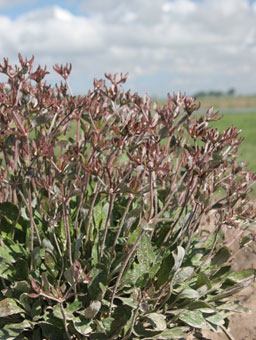James

Stephen Love, University of Idaho
Scientfic Name: Eriogonum jamesiiCommon Name: James' buckwheat
Description: James' buckwheat is a long-lived perennial with a woody crown and leaves that die back in winter. The leaves are covered with fuzzy hairs on both surfaces. Leaf color is light olive-green, often with reddish highlights. Flower color is dependent on variety, with var. jamesii having cream to buff flowers, and var. flavescens having bright yellow flowers. The flowers are arranged in large umbels and entirely cover the plant from June into September. In fall, the leaves take on a very attractive burgundy color. This plant attracts many mid-summer pollinators. James' buckwheat is a great subject for a xeric bed or border.
Native Habitat: Found in Wyoming, Utah, the southern Rocky Mountain States, and east into Oklahoma and Texas. Typically grows on prairies and foothills among grasses, pinyon pines, and junipers. Found at elevations ranging from 3,200 to 9,200 feet.
Cultural Requirement
Soil: Prefers a neutral to alkaline, nutrient-poor, well-drained soil. Tolerates clay soils if not over-watered.
Moisture Tolerance: Near-xeric conditions with limited supplemental water under dry conditions.
Sun/Shade/Preference: Full sun.
Transplanting: Easily transplanted as seedlings from flats into pots and easily transplanted from pots into the field.
Propagation: Best from seed. Germination often enhanced with a short (2-3 weeks) period of cold stratification. Seedlings can be susceptible to damping-off, a problem usually manageable with proper watering. Difficult from cuttings.
Maintenance (pruning, fertilization, deadheading, division, irrigation, etc): Plants should be dead-headed after bloom to improve appearance. The plants are otherwise very easy to care for, requiring limited irrigation (one to four times during dry years) and little or no fertilization.
Insect, disease, or other problems: James' buckwheat has no pests of consequence.
Landscape Value
Use in the Landscape: Very effective in xeric landscapes when planted with other low-to-medium height plants, or in front of shrubs or taller plants. Contributes well in mounded beds or in border plantings. Can be used in either naturalized or formal designs.
Foliage: Long, light olive-green, somewhat narrow, fuzzy leaves. Some plants have significant red highlights in the leaves, a color that darkens in the fall.
Flower: The var. jamesii has cream to buff flowers that often darken into reddish or bronze hues as they age. The var. flavescens has bright yellow flowers. Individually tiny flowers are groups into tight, spherical heads; the latter arranged in large umbels, up to 6 inches across.
Timing: June, July, Aug, Sep
Color: Cream or yellow.
Fruit: Inconspicuous achene enclosed in a dried perianth. Each flower produces one seed
Form: Mounded form both in and out of bloom.
Texture: Moderately coarse.
Ultimate Size: In bloom - 12 to 15 inches tall; out of bloom - 6 to 10 inches tall. Plants are wider than tall, eventually reaching a width of 24 inches or more.
Rate of Growth: Moderately slow. The plant occasionally blooms sparsely the first year and progressively gets larger with more bloom in subsequent years.
Suggested Plant Partners: James' buckwheat complements other early-flowering buckwheats. Also looks good with upright perennials, including medium-sized native grasses, penstemon species, Lewis flax, and late blooming mint species such as Agastache cana or Salvia pachyphylla.
Availability: Occasionally available as potted plants at specialty nurseries. Seed can usually be purchased from the Eriogonum Society or from native plant seed suppliers.
Cultivars: None.
References:

